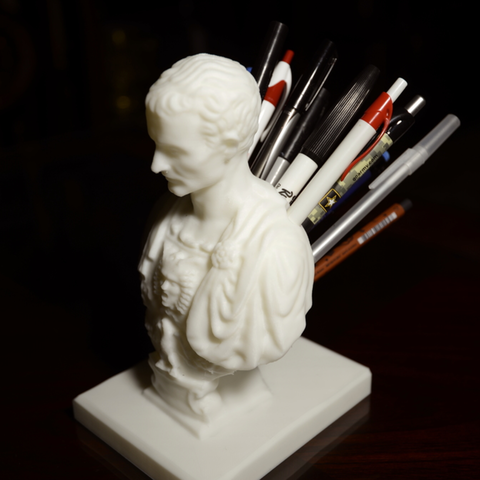
Julius Caesar (Improved) Pen/Pencil Holder
cults3d
History of Julius Caesar Gaius Julius Caesar, one of the world's most renowned military strategists, was born into a noble family with strong senatorial ties and was the nephew of another celebrated Roman general, Marius. Following Marius' death and Sulla's rise to power, Caesar's life hung in the balance for a time, but by the early 60s b.c., he launched his own successful campaign for both politics and military conquest. Rising rapidly through the ranks, he secured the consulship in 60 b.c. and forged an alliance with two prominent Roman leaders, Pompey the Great and Crassus, forming what would be known as the First Triumvirate. This powerful trio dominated Rome throughout the 50s b.c., until Caesar and Pompey went to war against each other following Crassus' death in 49 b.c. Did You Know? Unlike in Shakespeare's famous play, Caesar's final words were not "Et tu, Brute?" ("And you, Brutus?") but rather reported as "You too, my child?" During the height of the First Triumvirate, Caesar devoted his energies to conquering Gaul (modern-day France). After serving as consul in 59 b.c., Caesar became governor of Cisalpine and Transalpine Gaul (northern Italy and southern France), respectively. In 58, when the Helvetii in Switzerland attempted to migrate into central Gaul, Caesar took decisive action, halting their advance and sending them back to their homeland. Meanwhile, he had forged strong alliances with the chieftains of central Gaul, who urged him to protect them against a German invader from across the Rhine, Ariovistus. In the summer of 58, after defeating the Helvetians, Caesar marched against the Germans and drove them out of Gaul. Caesar was now deeply entrenched in the affairs of Gaul. Over the next several years, he led a series of brilliant campaigns that ultimately conquered all of Gaul and transformed it into a Roman province. The conquest required numerous challenging battles in northern Gaul and the crossing of the Rhine over a remarkable trestle bridge constructed by Roman engineers. In the summers of 55 and 54 b.c., Caesar sailed across the English Channel, securing his northern flank along the Rhine in Gaul by preventing a Celtic attack from across the Channel. Although Britain did not become a Roman province for another hundred years. Early in 49, as his command in Gaul was nearing its end, Caesar initiated civil war with his old associate, Pompey the Great, who had allied himself with the Roman Senate against Caesar. In a stunning blitzkrieg, Caesar invaded Italy and drove Pompey into Macedonia within less than seventy days. Since Pompey had a fleet while Caesar did not, Caesar decided to strike at Spain, where Pompey had strong support, as his men constructed warships. Victorious in Spain, Caesar then sailed to Macedonia but could not dislodge Pompey from his base at Dyrrhachium (modern-day Durazzo). Caesar ultimately raised the siege, fell back into central Greece, and defeated Pompey at the Battle of Pharsalus in 48 b.c. Caesar was then drawn into a romantic affair with Cleopatra in Egypt and had to fight two more battles against the Pompeians, one in North Africa (Thapsus, 46 b.c.) and another in Spain (Munda, 45 b.c.). Triumphant across the Mediterranean, the great general met his demise at the hands of political rivals on the Ides of March in 44 b.c., as he prepared an invasion of the Parthian Empire. His leadership was characterized by boldness, decisiveness, and a willingness to take calculated risks. (From History.com) http://paypal.me/henryqiu ^^ Please consider leaving a tip at the link above or clicking here to help me continue posting free models such as this in the future. Cheers! ^^
With this file you will be able to print Julius Caesar (Improved) Pen/Pencil Holder with your 3D printer. Click on the button and save the file on your computer to work, edit or customize your design. You can also find more 3D designs for printers on Julius Caesar (Improved) Pen/Pencil Holder.
